Carmen – No Man’s Woman
An Opera. Stage shows. Musicals. Multiple film versions, including a Flamenco-based film. Even a Bollywood Film. A story that continues to fascinate. About a free-spirited woman who can’t or won’t be subdued by any man.
“No one tells Carmen’s eyes where to go but Carmen”.
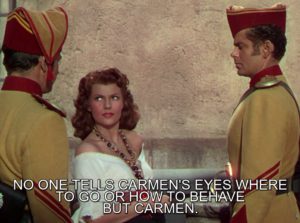
That line summarises her character. If she is fiery, a thief, of “loose morals”, without any scruples, it is all explained as part of her “Gypsy Blood”. The trouble lies in the source material, Carmen, the novella. Published in 1845, it conforms to and confirms all the stereotypes of those days, including that of faithless, morally decadent Gypsies. Pushed into a corner, what choice did the Gypsies have?
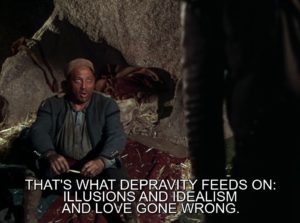
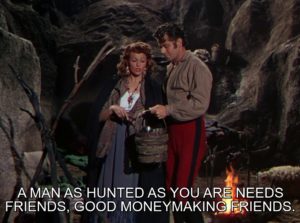
For centuries, Gypsies were often looked down upon as dregs of civilized society and treated severely. Gypsies were persecuted so much that the uber crackpot Hitler added them to his long list of unfortunates who had to be “exterminated” since they were seen as “subhumans”. Strangely the mysterious origins of The Gypsies have roots going back to India.
With that background, Carmen’s story makes fascinating cinema. Film always gives the director the freedom to play around with the film’s structure. Thus, there are various interesting versions – some that stick to the original story, in the original socio-economic background and times, while others tell the story in an “updated” “modern” context.
The Loves of Carmen (1948) is linear storytelling with a start, a middle, and an end. The whole film rests on Rita Hayworth, who does a magnificent job. “The Love Goddess” ( as she was christened by the press and public) is in fine form as the independent Carmen who only looks out for herself by playing off suitors against each other. It may be the Gypsy in her, but Hayworth takes it one step ahead. We can’t determine whether it is Carmen or Hayworth delivering the lines with aplomb. This is one of those cases where the character and the performer come together, and all the other characters pale into insignificance. Glenn Ford is excellent as Don Jose, who loses it all – literally and figuratively – by pursuing Carmen. His spirit. His mental balance and acumen. His name and prestige. Carmen, the ghost, haunts him until he is consumed by it.
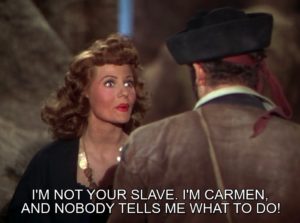
In keeping with the times and the original story, there are many references to omens, signs, fortune-telling, and whatnot. It may look superstitious, but it helps to forward an essential part of the story. Carmen may be a blite spirit but she is true to her Gypsy heritage and is utterly superstitious.
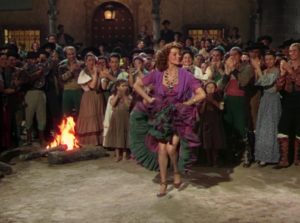
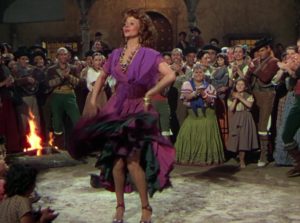
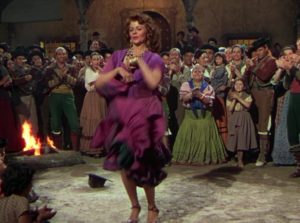
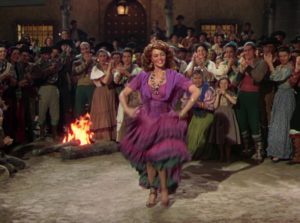
The 1946 version was remade in India as Jadoo (1951) with the same story. The cast even wears “Spanish” style dresses as in the 1948 Hollywood version while having very Indian names such as Sundari (Carmen), Pritam (Don Jose) and so on.
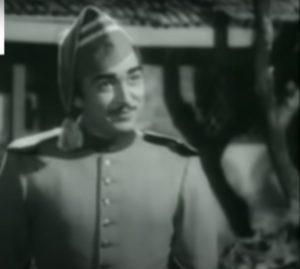
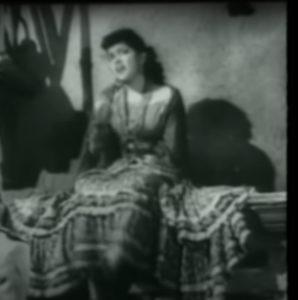
The music by Naushad saw the first-ever use of castanets as a supporting instrument. Naushad does a cheeky lift of the original phrase “lara loo lara loo” and copies it into the Shamshad Begum song “Jab nain miley nainon se”.
Carmen (1983) by Spanish Master Carlos Saura is a pure visual delight. A Flamenco dance troupe is rehearsing the Bizet opera. Predictably the lead choreographer, Antonio (Antonio Gades – a renowned Flamenco dancer), falls obsessively in love with the new dancer Carmen (Laura del Sol – a trained Flamenco dancer), who is no one’s fool and couldn’t care less about any male wanting to possess her. This was the first version of the Carmen saga I saw, and I was simply blown away by the “story within a story”.
This version is an incredible delight as you watch the story within the story. The flamenco dancers rehearse the opera, and the story comes true for Antonio as he is haunted by Carmen’s “spirit” – literally and figuratively. Words can’t express the sheer visual delight as we watch the dancers going through their paces.
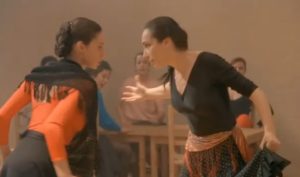
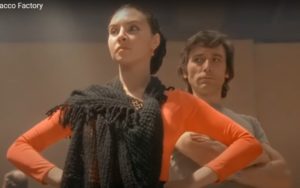
Filming dance is an art, and Master Saura does it perfectly. The music is by the great Flamenco master guitarist, the late Paco de Lucia, who makes an appearance in the film as a musician. It is simply impossible to discuss the sheer audio-visual delight of this film.

Prenom Carmen (1983) is an “in your face” version. The premise? Would-be bank robber terrorist Carmen robs a bank whose armed policeman guard falls in love with her. As befitting a “modern” French film, there is a lot of extended nudity. Made by Jean Luc Godard, it is one of those films with a nonlinear structure that may leave you a little “breathless” 😉
An interesting version is Carmen Jones (1954), with an all-black cast directed by Hollywood Rebel Otto Preminger. It was the mid-1950s, and major studios still looked down upon an all-black cast as not belonging to mainstream cinema. Accordingly, Preminger produced it himself, and the result is there for everyone to see. The story is set against the background of WW2 and in the Southern States with Harry Belafonte (Joe) in the Don Jose role and Dorothy Dandridge (Carmen Jones) as Carmen.
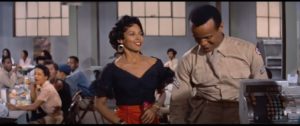
This is probably the most innovative “modern update” – setting Bizet’s opera in modern times and in the Southern States during WW2. Belafonte and others’ singing voices are dubbed; it would have been interesting to hear some of the cast singing in their own voices. The songs are based on the 1943 Oscar Hammerstein stage musical of the same name.
https://archive.org/details/carmen-jones-1954
There are more versions out there that stick to the original story but have graphic nudity in keeping with “modern” times. For me, the 1946 version and the 1983 Saura film have more eroticism than any version with graphic nudity. I suppose we can all take refuge in the saying, “beauty is in the eye of the beholder”.
I saw the Saura version on its initial release in 1983. I was simply blown away by the sheer imagery – Flamenco music and dance. This remains my favorite version, and I would rate it a perfect 5 out of 5. It is free on YouTube but unfortunately without any English subtitles. With visuals like these, who needs subtitles https://youtu.be/n0hg9J5z-To
My next favorite is – but naturally – the 1946 version with Rita Hayworth. (I wonder how Jadoo stacks up against it). It’s free on YouTube. I would rate it at 4 out of 5.
https://www.youtube.com/watch?v=sUI7-rmIe30
As for Carmen and her “Gypsy blood” and being a non-conformist, no doubt the character was a product of its times, but most 21st-century readers or viewers will probably label her as a feminist. Rita Hayworth is the moving force in the 1946 version where all other actors pale in comparison.
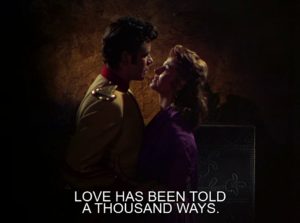
There was some talk about Shyam Benegal filming a version in the early 2000s but nothing much came of it and the only Indian version remains Jadoo.
For me. the Carlos Saura version stands way above all the others.
Awesome Ramesh! Want to catch every version now!
It should be easier for you as some of the versions that are unavailable in India can be easily viewed in US.
Brilliant Ramesh . Your style of writing these pieces is truly excellent
Thanks, Murli. Do share within your circle of friends:)
Interesting premise and so many versions of it.Seems like a good watch.